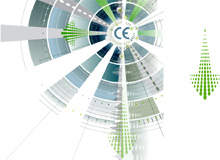
Medical electrical device standards have changed dramatically in the last 15 years, beginning with the introduction of European CE marking in 1993. This has risen to become the global benchmark for electrical device testing – a status once held exclusively by US FDA regulations.
In 2005, an expanded third edition of the IEC 60601-1 broadened its scope by addressing risk management. The revision also expanded safety concepts to include essential device performance, ensuring the accuracy of critical monitoring equipment. There are also more stringent requirements for patient handling and support devices, which are considered to be 'Machines' under the European Machinery Directive. Collateral standards are underway for tightening up the requirements for development of safety critical software.
“Regulation has been stepping up fairly consistently,” says Clifford. “More and more countries throughout the world are respecting CE marking and taking it on board as a way of regulating outside Europe because it is globally viewed as a good system.
“The main difference between CE marking and FDA regulation is that, in the US, they have the ‘predicate device’ approach,” he explains. “If a new manufacturer makes a product and can demonstrate it is similar both in technology and medical use to a product that is already on the market and has been approved for several years, then their product will bypass a lot of the regulatory barriers, making for a much quicker approval process.
“However, if it is a new technology, treatment or diagnostic method, it will be a very long and laborious process to market.
See Also:
“In the CE marking regime, the predicate device approach does not exist. It's the same route all the way through for all products. So, new devices entering the US market will be significantly slower to reach approval than in Europe.”
How well do you really know your competitors?
Access the most comprehensive Company Profiles on the market, powered by GlobalData. Save hours of research. Gain competitive edge.

Thank you!
Your download email will arrive shortly
Not ready to buy yet? Download a free sample
We are confident about the unique quality of our Company Profiles. However, we want you to make the most beneficial decision for your business, so we offer a free sample that you can download by submitting the below form
By GlobalDataBoth regulatory systems focus on Good Manufacturing Processes or the quality system approach to allow manufacturers to demonstrate that they make safe devices, and like technical standards these have changed significantly over recent years.
Managing risk
According to Clifford, current standards for regulating electromedical devices are heavily based on risk assessment/analysis because these devices are intrinsically hazardous. “The way they are used poses arguably greater risk and certainly different risks than any other household or industrial product,” he says. “So, medical device manufacturers have to carry out an assessment to show that any risks associated with their device are acceptable when weighed against the potential benefits to patients.
“Manufacturers who have not adequately documented their risk management system will find it very difficult to do so in retrospect. Previously, manufacturers could just make a product, have it tested and that was ok. With the new standards, device manufacturers can't do that. They have to demonstrate that their product has been designed from the start with risk analysis at the core. There is a lot of documentation needed to provide the evidence that it has been done.”
The push towards risk assessment/analysis-centric standards has picked up momentum over the past few years, according to Clifford, and represents a significant change from previous guidelines. Patient risk is determined from the probability of harm combined with the severity of potential injury. ISO 14971 requires ‘risk management files’ to accompany all electromedical devices being reviewed. These must include:
- a risk management plan
- description of the product's intended use or purpose
- a statement listing any foreseeable product misuse
- an estimate of associated risks/foreseeable hazards associated with the product.
The risk management file must disclose the results of risk evaluations, residual-risk evaluations, a risk/benefit analysis and a risk management report. Manufacturers must also demonstrate continual assessment of product risk management profiles to ensure they are up to date with existing technologies, results of research and experience of use. EN60601-1: 2006 now allows electromedical equipment to exhibit characteristics that would normally be construed as a failure, as long as the manufacturer's risk assessment demonstrates that the risks associated with these characteristics are acceptable with respect to patient benefit.
Long-term studies
Research and long-term experience of use have significantly influenced current standards as well, according to Clifford. “As research continues on new diseases and infection control methods, results may show, for example, that PVC – a commonly used material – has hazards associated with it that were not noticed before,” he explains. “That has a significant impact on manufacturers because they must then source a new material for their product. These things normally arise from research or experience in clinical use, rather than from a designer's point of view or advances in technology.
“Cardiac defibrillators, another example, have been in use for 30–40 years and the principle mechanisms of the device remain the same. But there have been at least two major changes. One is the recognition of a critical time element from the onset of heart attack to treatment. Research has demonstrated that by the time a patient reaches hospital, it is often too late. So there has been a big movement to get defibrillators out into the public domain. In the US, that has happened faster than anywhere else. Defibrillators can be found in railway stations, offices and so on.”
Secondly, research into restarting the heart, and changes in technology and relaxing of technical requirements in the standard, based on risk assessment, have allowed smaller and cheaper defibrillators to be made, allowing them to be more readily available.
Advances in technology
Though new technology does have significant impact on standards, it has relatively little effect on regulatory frameworks, especially with regard to risk analysis, according to Clifford. “As devices such as high-voltage defibrillators get smaller, tighter and more compact there tend to be increasing issues about safety, because normally high-voltage products need to be bigger to keep components separated. And so the regulatory framework is taken on board by the risk assessment approach. Technology has allowed these higher voltages to be used in products more safely.
“I think the regulatory framework comes from: a) maintaining safety, which is obviously paramount, so that really hasn't changed. But also, b) allowing development of new devices with new technology without rigid boundaries that inhibit beneficial treatment for patients, and c) getting the manufacturers to do most of the work by maintaining their technical file and quality system,” explains Clifford.
Keeping pace
In order to maintain product compliance, many medical device manufacturers rely on organisations and consultancies whose primary focus is to keep abreast of all relevant regulatory changes. “A lot of manufacturers rely on specialised firms to keep pace,” says Clifford. “Though some of the bigger companies have enough resources to do this for themselves, there are a significant number of high-tech medical device manufacturers who don't have that resource.
“For example, high-tech electromedical equipment manufacturers may not have expertise in biocompatibility materials. So, that needs to be outsourced. It would be very beneficial to them to use a third party, who either have the expertise or can dedicate their time to doing continual market research to determine where these new issues arise.”
Although medical device standards vary less and less between EU countries, the primary challenge for manufacturers is finding out where the differences lie. “A UK manufacturer, for example, will use a UK notified body to approve the CE marking,” says Clifford. “And although the CE mark means the device has free movement throughout Europe, there are barriers to trade.”
What happens in practice is that typically, Germany, France or any other state will have its own internal regulations which prohibit certain things. So, medical device manufacturers can find that they have to perform a design check for each country within Europe because of their individual regulations, which may be independent of the medical device industry. It could be to do with electrical supplying or something else.
“For example, third-party accessories for an electromedical device can be CE marked if demonstrated to be safe to use with any manufacturer's device in general terms,” Clifford explains. “Some states require that the accessories are actually tested with every single device and can only be sold in that state without a fully detailed test report; a requirement above that of CE marking.”
Overall, Clifford believes the larger EU medical device markets are relatively homogenous. However, European medical device manufacturers who want to sell their products in the US will find the route to market challenging. This is mainly due to financial strain because having gone through the process in Europe, it costs at least the same again to go through the US FDA, even though the requirements are largely similar.
Looking to the future, although the Medical Devices Directive is being amended, Clifford doesn't anticipate any major changes to regulations. “There are always small changes by countries which may create barriers to trade,” he concludes. “But CE marking started several years ago. Further, the US standards system is moving towards harmonising with the IEC standards, on which most European standards are based. I think globally people are seeing CE marking as being the best.”




